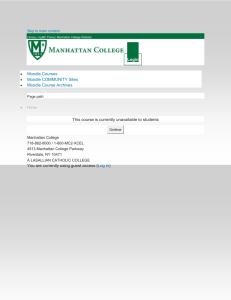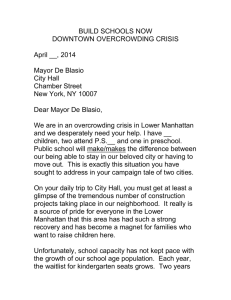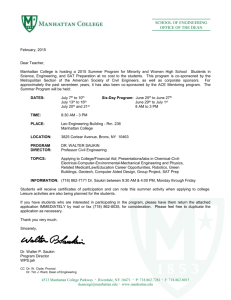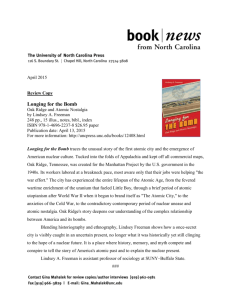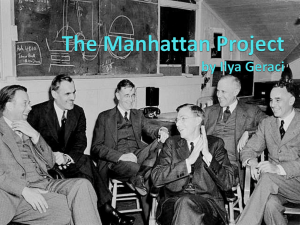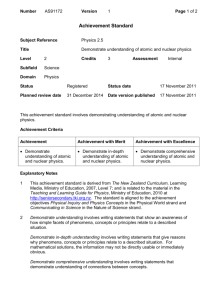ManhattanProjectPathfinder
advertisement
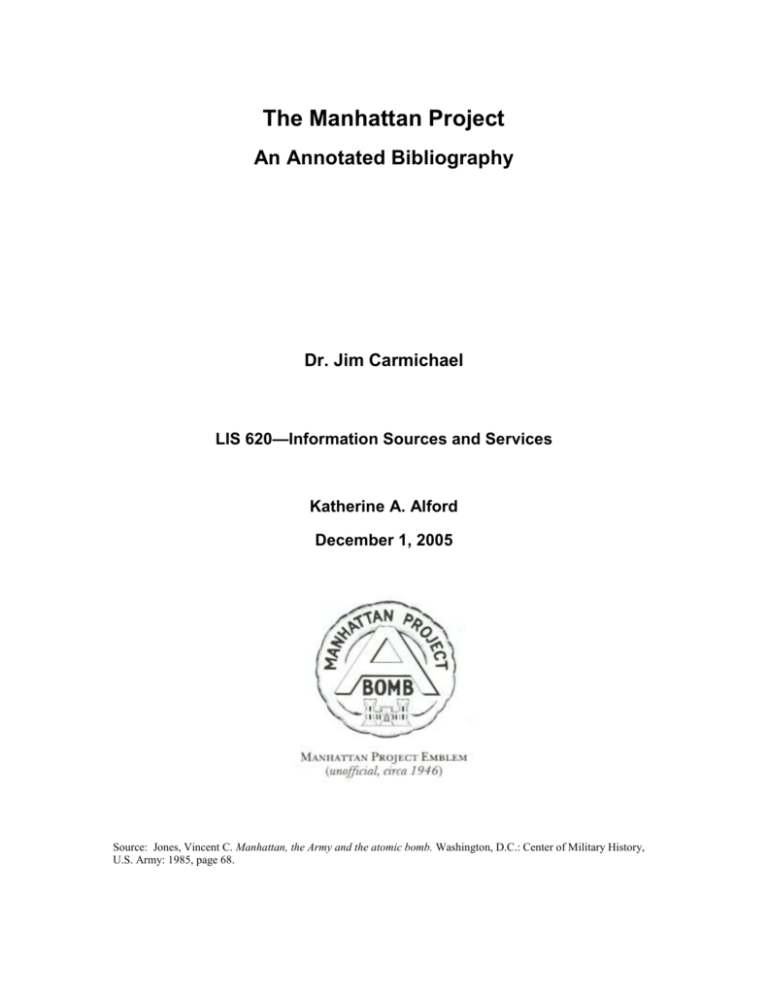
The Manhattan Project An Annotated Bibliography Dr. Jim Carmichael LIS 620—Information Sources and Services Katherine A. Alford December 1, 2005 Source: Jones, Vincent C. Manhattan, the Army and the atomic bomb. Washington, D.C.: Center of Military History, U.S. Army: 1985, page 68. TABLE OF CONTENTS SCOPE …………………………………………………………………………………..… 3 INTRODUCTION …………………...……………………………………………………. 3 SUBJECT HEADINGS AND CLASSIFICATION …………………………………….… 5 MANHATTEN PROJECT TIMELINE………………………………………………..… 6 DICTIONARIES AND SUBJECT ENCYCLOPEDIAS ……………………………….… 7 INDEXES AND BIBLIOGRAPHIES ………………………………………………….…. 8 ATLASES ………………………………………………………………………….……… 8 BOOKS…………………………………………………………………………..………8-10 BIOGRAPHIES……………………………………………………………………..………10 PHOTOGRAPHY BOOKS …..………………………………………………..……………11 WITH NUCLEAR THEMES RELATED TO …………………………………… 11 THE MANHATTEN PROJECT…………………………………………………... 11 INTERNET SOURCES …………………………………………………………………… 11 GOVERNMENT DOCUMENTS………………………………………………………..… 12 MAP OF THE MANHATTAN PROJECTS …………………………………..……………13 VARIOUS OPERATING UNITS, 1942—1946 ……………………………………13 PROCURING ESSENTIAL MATERIAL……………………………..……………13 BOOKS FOR YOUNGER READERS………………………………………………….… 14 2 SCOPE The Manhattan Project was a secret government project that was led by a group of renowned scientists, engineers and army officers during World War II to produce an atomic bomb. Their goal was to harness this new science before Germany or Japan could turn this science and technology on the United States and thus win the war. The Manhattan Project was the code name for America’s atomic bomb development efforts during this war time. The name originated as part of the U. S. Army Corp of Engineers and was organized under the Manhattan Engineer District in New York City. The MED (Manhattan Engineer District) included all of the labs and installations that were scattered throughout the country. One cannot fathom the infinite aspects of our lives that the Manhattan Project has had an effect upon. Sources included in this annotated bibliography touch mainly on the scientists, the military and life on the larger sites during the period of 1942 through 1946. Minor attention is given to both pre and post events as they relate to this secret mammoth project. INTRODUCTION World War II started on September 1, 1939 when Germany attacked Poland. By 1941 the Germans were leading the race for the atomic bomb. Germany had a heavywater plant, high-grade uranium compounds along with scientists and engineers and the greatest chemical engineering industry in the world. The United States luckily had accepted various international scientists, including the infamous Albert Einstein; all were looking for asylum from Adolph Hitler’s German war machine. America remained neutral as long as she could until that infamous date of December 7, 1941 when the Japanese attached Pearl Harbor. From that point forward the United States knew they needed all the ammunitions in their arsenal and as fast as possible to fight and be victorious over these two foes. Between August and October 1939 Albert Einstein and President Roosevelt exchanged correspondence discussing how imminent it was that America develop the atomic bomb before the Germans did. President Roosevelt stated he was convening a board with representatives from the Bureau of Standards, the Army, and the Navy to investigate Einstein's suggestions. This set into motion the events which led to the Manhattan Project. General Leslie R. Groves, Deputy Chief of Construction of the U.S. Army Corps of Engineers, was appointed to direct this top-secret project. Groves established three large engineering and production centers at remote U.S. sites: the Clinton Engineer Works at Oak Ridge, Tenn; the Hanford Engineer Works in eastern Washington State; and Project Y, a code-named site 100 miles north of Albuquerque at Los Alamos, N.M. Meanwhile, experiments in a small laboratory beneath the University of Chicago's abandoned Stagg Field were expanding understanding of atomic theory. The first controlled nuclear reaction occurred under Stagg Field. Italian physicist Enrico Fermi managed the University of Chicago reactor, called Chicago Pile 1 (CP-1). Nobel Prizewinner Fermi had fled Fascist Europe. On the afternoon of December 2, 1942, it happened. Under the abandoned west stands of Stagg Field, the first controlled nuclear 3 reaction occurred. Humankind had controlled energy released from the nucleus of the atom. CP-1 paved the way for Oak Ridge and Hanford to develop ways of obtaining nuclear fuel for atomic weapons. Scientists now had to create the fuel for an atomic bomb. The Oak Ridge facility separated the nuclear fuel U-235 from U-238, natural uranium. The Hanford Engineer Works produced plutonium. Theoretical physicist Oppenheimer, who would direct Los Alamos research, identified top scientists and engineers from universities nationwide. At Los Alamos, an international team of scientists and engineers labored around the clock to create the first atomic weapons. In November 1942, General Leslie Groves and physicist Oppenheimer chose the site where the first atomic bombs were designed and built. The site at Los Alamos, N.M. had been a boys' school and Oppenheimer had visited it in the 1920s. By March 1943, Los Alamos had become an intellectual boomtown. Known as "the hill," Los Alamos produced two bombs. One, nicknamed Little Boy, was a gun-type weapon that used U-235. A slug of U-235 would be projected down a gun barrel into the center of another piece of U-235. When combined, a nuclear explosion would occur. The second bomb, Fat Man, used implosion to detonate plutonium. Here, explosives would surround the plutonium ball. When detonated, they would compress the plutonium, causing a nuclear explosion. Much controversy has occurred as more and more information has become de-classified. Many of the ethical issues surrounding atomic energy were not given too much thought, even by the scientists at the time. They were motivated by war time and the race to be first to harness the nuclear ‘solution’. As we moved into the Cold War error many questions and issues surrounding the Manhattan Project need to be looked at with renewed fever if we are to keep nuclear power at bay. An example of a WWII Poster expressing the need to not divulge what people are working on during this period in our history. Source: afsf.lackland.af.mil/ Images/WWII/ 4 SUBJECT HEADINGS AND CLASSIFICATION Library of Congress Subject Headings Manhattan Project (U.S.)--History. Manhattan Project (U.S.)--Biography. Atomic bomb--United States--History. Oppenheimer, J. Robert, 1904-1967. Los Alamos Scientific Laboratory--History. Los Alamos Scientific Laboratory--Biography. World War, 1939-1945 -- Japan World War, 1939-1945 -- Soviet Union World War, 1939-1945 -- United States World War, 1939-1945 -- Chronology World politics -- 1933-1945 World War, 1939-1945 -- Campaigns -- Pacific Ocean – Encyclopedias World War, 1939-1945 -- Pacific Area -- Dictionaries World War, 1939-1945 -- Japan -- Dictionaries Sino-Japanese Conflict, 1937-1945 – Dictionaries Atomic bomb victims -- Health and hygiene -- Japan Nuclear disarmament -- Bibliography Nuclear warfare -- Bibliography Arms race -- Bibliography Nuclear energy -- Bibliography Peace -- Bibliography United States. Army. Corps of Engineers. Manhattan District -- History 5 6 DICTIONARIES AND SUBJECT ENCYCLOPEDIAS Ruffner, Frederick G. Code names dictionary A Guide to Code Names, Slang, Nicknames, Journals, and Similar Terms. Thomson Gale June, 1963. This dictionary has a section on atomic energy that gives definitions relating the atomic age. Additional terms defined are related to aviation, rockets and missiles, military, aerospace, metrology, communications, and others. Carlisle, Rodney P. Encyclopedia of the atomic age. New York: Facts on File, 2001. Of approximately 450 entries, about a quarter of these are biographical sketches; a tenth explain concepts and terminology relating to atomic energy, such as nuclear winter, plutonium, and quantum theory; and the remainder describe government programs, treaties, and important events in nuclear history. Main entries are arranged alphabetically by subject. The volume treats a wide assortment of topics, including the importance and roles of groups and programs such as Plowshare and the Federation of American Scientists, accidents at nuclear reactors, test sites, precedent-setting government reports, and antinuclear demonstrations. Atkins' writing is clear and concise and expresses the significant details and facts relating to each entry. The average entry is a little less than a page in length and concludes with suggestions for further reading. Wells, Anne Sharp. Historical dictionary of World War II: the war against Japan. Publisher Lanham, Md.: Scarecrow Press, 1999. This dictionary was a great resource for referring to Japanese military personnel and terms that were used while reviewing the military references. World War II in the Pacific: an encyclopedia. Stanley Sandler, editor. Publisher New York: Garland Pub., 2000. This encyclopedia was helpful to see how the pacific arena or theater of war described how determined the Japanese were to win this war. From this account I can see how the Japanese would not accept defeat. Kamikazes were explained as airmen who would not give up no matter what and if need be would fly their planes directly into battle for maximum kill power. 7 INDEXES AND BIBLIOGRAPHIES Worth, Roland H. Jr. World War II resources on the Internet. Jefferson, N.C.: McFarland, 2002. This publication came with a CD-ROM that was helpful in reviewing internet sources. World War II: day by day. London; New York: Dorling Kindersley Pub., 2001. This publication was very helpful in recounting the day by day events from a military and global vantage point. Schull, William J. Effects of atomic radiation: a half-century of studies from Hiroshima and Nagasaki. New York: Wiley-Liss, 1995. The atomic papers : a citizen's guide to selected books and articles on the bomb, the arms race, nuclear power, the peace movement, and related issues. Grant Burns Publisher Metuchen, N.J.: Scarecrow Press, 1984. These above sources include great bibliographies and indexes for further research. ATLASES Goodenough, Simon. War maps : World War II, from September 1939 to August 1945, air, sea, and land, battle by battle. Publisher New York: St. Martin's Press, 1982. BOOKS Bird, Kai and Sherwin, Martin. American Prometheus: The Triumph and Tragedy of J. Robert Oppenheimer. New York: A.A. Knopf, 2005. This book provides a comprehensive biography of J. Robert Oppenheimer. A solid understanding of his childhood is portrayed while he was living on Manhattan's Upper West Side and the influences of attending New York City’s Ethical Culture School are included. This book provides a detailed examination of Oppenheimer's left wing influences and the repercussions in his later life. Hasegawa, Tsuyoshi. Racing the enemy: Stalin, Truman, and the surrender of Japan. Cambridge, Mass.: Belknap Press of Harvard University Press, 2005. 8 This author not only uses effectively both U.S. and Japanese sources, but also the former Soviet archives. Hasegawa presents a much more thorough and complex picture of the military and diplomatic endgame than that offered by previous studies of Japan's surrender. Hasegawa convincingly shows that the Soviet entry into the war on August 9 had a much greater impact on Japan's decision to surrender than did the atomic bombings of Hiroshima and Nagasaki. This is an excellent resource for reviewing new arguments involving the atomic bomb. Conant, Jennet. 109 East Palace: Robert Oppenheimer and the secret city of Los Alamos. New York: Simon & Schuster, 2005. This book tells the story of the people of the Manhattan Project. The author of this book is the granddaughter of a Manhattan Project administrator, Dorothy McKibben. The office where she worked was the gateway to the Los Alamos complex in Santa Fe, New Mexico. In narrative form the book brings to life day-to-day experiences of the scientists, technicians and families at the site. This source highlights the creation of a unique place and time in which the bomb was built and less on the science of building the bomb. Examples include how the women rebelled against the military project director, General Leslie R. Groves, forcing him to let them organize schools, churches, a library, and a radio station. McKibben was the sympathetic ear for many of the residents frustrated by the extraordinary security and secrecy at Los Alamos. Most families had no idea what the scientists among them were working on. The inhabitants would regard it as a prison camp. There were guards, dogs, censored mail, and tapped phones. At the same time, there were families, schools, a golf course, and cocktail parties just like those of any other American town. An essential read for a true feeling of people who worked at the Los Alamos site. Jones, Vincent C. Manhattan, the Army and the atomic bomb. Washington, D.C.: Center of Military History, U.S. Army: 1985 Based primarily upon the archival records created by the Manhattan Project from 1942 to 1948, this book has a multitude of information not found in any other source. Included are personal papers of many of the military leaders and scientists who played important roles in the development of the atomic bomb. Published sources contained in this work are manuscript histories, interviews and correspondence, plus U.S. Government Publications such as the 1946 Atomic Energy Hearings. The bibliography holds a wealth of sources pertaining to the Manhattan Project, broken down into areas ranging from the Department of the Army, Office of Scientific Research and Development to the Department of Energy. Further listings under Japan, United Kingdom and Personal Accounts, Memoirs, and Collected Papers give a good idea of how the Army Corps of Engineers directed the secret effort. A must read on this topic. There are pull-out organization charts of the project along with wonderful detail of behind the scenes activity on key decisions made during this time of history. Several key maps of the United States and major project areas are included. The map on page 13 shows the vast number of installations involved throughout the country, including university laboratories. 9 BOOKS continued Coster-Mullen, John. Atom Bombs: The top secret inside story of little boy and fat man. John Coster-Mullen, 2002. This book is the product of over seven years of research and hundreds of interviews with Manhattan Project, Project Alberta, and 509th personnel. The secret inner workings of both atomic bombs are revealed here for the first time along with numerous untold stories of both strike missions. Groves, Leslie R. Now it can be told; the story of the Manhattan project. New York, Harper 1962. Leslie Groves gives the reader a detailed look at how he organized as a general, the many components of the Manhattan Project. Hales, Peter Bacon. Atomic spaces: living on the Manhattan Project. Urbana: University of Illinois Press, 1997. This was an excellent way to not only see how people of the Manhattan project lived day to day, but the detail of their stories makes this book a must to understanding everyday life during this period of time. BIOGRAPHIES . These biographies provide a very interesting perspective in contrast to the workers and military personnel who also worked on the project. These biographies are of the various scientists that worked on the Manhattan project Conant, Jennet. 109 East Palace: Robert Oppenheimer and the secret city of Los Alamos. New York, Simon & Schuster, 2005.. From a life of physics. Edited by H. A. Bethe and others. Singapore, Teaneck, NJ, World Scientific, 1989. Herken, Gregg. Brotherhood of the bomb: the tangled lives and loyalties of Robert Oppenheimer, Ernest Lawrence, and Edward Teller. New York, Henry Holt and Co., 2002. Bibliography: 417-428. Hoffmann, Klaus. Otto Hahn: achievement and responsibility. New York, Springer, 2001. Bibliography: p. 261-264. 10 Howes, Ruth H., and Caroline L. Herzenberg. Their day in the sun: women of the Manhattan Project. Philadelphia, PA, Temple University Press, 1999. Bibliography: p. 237-251. York, Herbert F. The advisors: Oppenheimer, Teller, and the superbomb. With a historical essay by Hans A. Bethe. Stanford, CA, Stanford University Press, 1989. Includes bibliographies. PHOTOGRAPHY BOOKS WITH NUCLEAR THEMES RELATED TO THE MANHATTAN PROJECT Tredici, Robert del. At work in the fields of the bomb. New York : Perennial Library, 1987. Tredici looks at nuclear power facilities and includes an interview with Berlyn Brixner. who is best known as being the head photographer for the Trinity test. Brixner was stationed 10,000 yards away from the explosion itself, but had around 50 cameras of different speeds running from different locations to capture the shot in full motion. Most photographs of the test were set up, arranged, and prepared by Brixner. Gallagher, Carole. American Ground Zero the secret nuclear war. Cambridge, Mass. : MIT Press, 1993. For seven years Carole worked on American Ground Zero: The Secret Nuclear War, a book that documents the aftermath of nuclear testing in Utah and the West’s "culture of cancer" through photography and oral history. INTERNET SOURCES Manhattan Project Heritage Preservation Association, Inc. (MPHPA) http://www.childrenofthemanhattanproject.org/ Excellent website for all aspects of the Manhattan Project. Items include information on the scientists, timelines, memorabilia and all points in between. As the title in the website describes, this is all about the children of the Manhattan Project. It has a digital library, the website is updated frequently and as more people are found that worked on the various projects these individuals are added and can even request a newsletter. 11 GOVERNMENT DOCUMENTS United States. Congress. House. Committee on Resources Title Manhattan Project Sites Study Act of 2004 : report (to accompany H.R. 3207) Publisher: Washington, D.C.: U.S. G.P.O., 2004 Y 1.1/8:108-744 MICROFORM US This government document is an interesting report of the cost of the Manhattan project. Includes cost estimate of the Congressional Budget Office. Trinity site, July 16, 1945. Publisher Washington, D.C.: Dept. of the Army, 2004 D 101.2:T 73/1945 This is a small booklet that has a picture of an atomic bomb explosion on the front cover. It has facts about the Trinity site, along with a map on the back cover and on the inside back cover there is a picture of the patch shown below. Each symbol is explained in detail. This is a very nostalgic and interesting government pamphlet. MANHATTAN PROJECT SHOULDER PATCH - ORIGINAL 1945 PATCH (60 Years Old). All military personnel of the Manhattan Project received this shoulder patch soon after the war was over. This patch is an actual Manhattan Project patch. Source: http://www.childrenofthemanhattanproject.org/STORE/01SPECIALS/Pages/Store_01_008.htm 12 Map of the Manhattan Projects various Operating Units, 1942—1946 Procuring Essential Material Source: Jones, Vincent C. Manhattan, the Army and the atomic bomb. Washington, D.C.: Center of Military History, U.S. Army: 1985, pg 63. 13 BOOKS FOR YOUNGER READERS Akasaka, Miyoshi. Daigo-Fukuryumaru: the witness on the ocean. Translated by Tomoko Kinoshita. Tokyo, Kin no Hoshisha, 1990. 41 p. UF767.A34713 1990 Translation of Wasurenai de. Anderson, Dale Milwaukee. The atom bomb project. Milwaukee, WI, World Almanac Library, 2004. 32 p. QC773.3.U5A56 2004 Bankston, John. Enrico Fermi and the nuclear reactor. Bear, DL, Mitchell Lane Publishers, 2003. 48 p. QC16.F46B36 2003 Crewe, Sabrina and Dale Anderson. The Atom Bomb Project. Milwaukee, WI, Gareth Stevens Publisher, 2005. 32 p. QC773.3.U5C73 2005 Foley, Michael. Harry S. Truman. Foreword by Walter Cronkite. Philadelphia, Chelsea. House Publishers, 2004. 106 p. E814.F65 2004 Lawton, Clive A. Hiroshima: the story of the first atom bomb. Cambridge, MA, Candlewick Press, c2004. 48 p. D767.25.H6L34 2004 Orr, Tamara. The atom bomb: creating and exploding the first nuclear weapon. New York, Rosen Pub. Group, c2005. 64 p. UG1282.A8O77 2005 Pasachoff, Naomi. Niels Bohr: physicist and humanitarian. Berkeley Heights, NJ, Enslow Publishers, c2003. 128 p. QC16.B63P37 2003 Whiting, Jim. Otto Hahn and the story of nuclear fission. Bear, DL, Mitchell Lane Publishers, 2004. 48 p. Bibliography: p. 46 QD22.H2W45 2004 14
